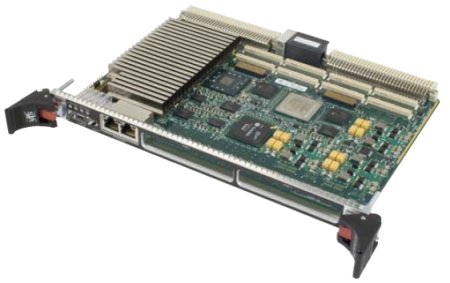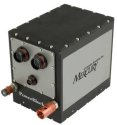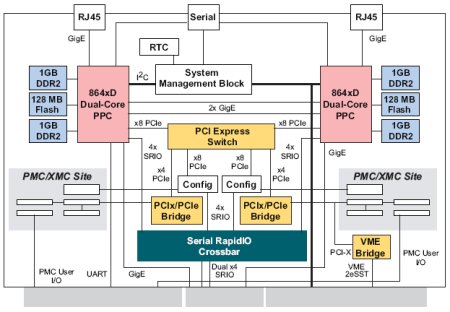PowerPC-based VXS board gains development support
Aug 5, 2009 — by Eric Brown — from the LinuxDevices Archive — 16 viewsTimesys says its subscription-based LinuxLink development framework now supports a new dual-core, Freescale 8641D PowerPC-based single-board computer from Mercury Computer Systems. Mercury's Ensemble 5000 Series VXS HCD5220 offers dual PMC/XMC mezzanine sites and serial RapidIO, and is designed for sensor-networked environments such as radar installations and other military and industrial applications.
Announced in April, the now-shipping Ensemble 5000 Series VXS HCD5220 single-board computer (SBC) is the first in a series of Ensemble 5000 VXS systems designed for rapid access to critical information from distributed sensors using its Converged Sensor Network (CSN) architecture, says Mercury Computer. The HCD5220 can function as an SBC or as part of an embedded processing cluster. The 6U serial RapidIO-enabled air-cooled module is compliant with the VXS mil/aero spec (see below for more on VXS).

Mercury's Ensemble 5000 Series VXS HCD5220
(Click to enlarge)
 |
Mercury also builds a number of computing systems based on PowerPC processors. Last year, for example, it shipped a portable, ruggedized PowerBlock 50 military computer (pictured) based on a Freescale PowerQUICC III processor.
Mercury's computers typically integrate image, signal, and sensor processing capabilities and target aerospace and defense applications. Other applications are said to include homeland security, industrial inspection, telecommunications, "and other computationally challenging markets," says the company.
One particular focus of the Ensemble 5000 Series VXS HCD5220 is said to be the area of "signals intelligence/electronic warfare" (SIGINT/EW) applications. By combining dual multi-core processors with "advanced switched-fabric topologies," the HCD5220 offers twice the image and signal processing performance of existing designs, claims Mercury.
For example, when configured with its Echotek Series Digital Receiver module options, the computer enables up to eight channels of processing, thereby "doubling the channel count per slot compared to previously available systems," says the company. The HCD5220's thermal design, meanwhile, is said to support the 1.33GHz Freescale 8641D processor in a standard 0.8-inch VXS slot.

HCD5220 block diagram
(Click to enlarge)
The HCD5220 is based on two Freescale MPC8641D systems-on-chip (SoCs), each containing two PowerPC e600 cores clocked at up to 1.5GHz (1.33MHz in this product), along with high-speed interconnects such as Serial RapidIO, gigabit Ethernet, and PCI Express. The MPC8641D also features dual memory controllers, and an implementation of Freescale's MPX bus capable of scaling to 667MHz. The HCD5220 is also available with Freescale's 1.06GHz MPC8640D SoC, a lower-power version of the 8641D.
Each MPC8641D SoC is supported with up to 2GB of DDR2 SDRAM and 128MB of flash. The boards are equipped with two internal and two external gigabit Ethernet interfaces, so on a large multi-board system, any processor can communicate with any other processor for system control, says Mercury. The SBC also offers 3.125-Gbaud Serial RapidIO switch topology for communicating application data.
Each of the board's dual PMC/XMC sites can be configured with off-the-shelf mezzanine cards using either PCI-X or PCI Express protocols, says Mercury. PMC cards are supported with a PCI/PCI-X interface at up to 133MHz on the primary site, and up to 100MHz on the secondary site, and PMC user-defined I/O is mapped to the backplane, says the company.
VXS: another heir to VME
As its name implies, the HCD5220 adheres to the VXS architecture (Vita-41), which is currently in competition with VPX, also known as "VITA 46," a mil/aero spec that is similarly maintained by VITA (VME Industry Trade Association).VPX is said to offer improved connector technology compared to VITA's VMEbus standard, including support for modern bus technologies, while VXS is an update to VME that adds support for modern serial interconnects.
 |
Other Linux-compatible VPX SBCs include the X-ES XPedite7170, the VPX6-185 from Curtiss Wright Controls (CWC), and the GE Fanuc VPXcel3 SBC320 M. Other VXS-compatible systems running Linux include Concurrent Computer's iHawk VME computer (pictured at left). The iHawk runs Concurrent's Red Hawk Linux distribution.
Specifications listed for the Mercury Ensemble 5000 Series VXS HCD5220 include:
- Processor — 2 x dual-core Freescale MPC8641D at up to 1.33GHz (optional MPC8640D at 1.06GHz
- Memory — Up to 2GB DDR2 SDRAM per processor at up to 533MHz
- Flash — 128MB boot/application flash per processor
- PMC-XMC — 2 x sites with:
- PCI-X-to-PCI Express bridge to onboard PCI-e switch
- PCI support at 33MHz and 66MHz
- PCI-X support
- Primary site at 66/100/133MHz
- Secondary site at 66/100MHz
- PMC user-defined I/O from P4 to VME P2
- PCI-e XMC sites per VITA 42.3; or serial RapidIO XMC sites per VITA 42.2
- VME interface — 2eSST capable via Tundra TSi148
- Networking — 4 x gigabit Ethernet ports (2 x front facing; 2 x backplane ports per VITA 41.6)
- Serial — RS-232 interfaces to front-panel interface; additional serial interface optionally routed to backplane
- Other features:
- Real-time clock
- Watchdog timer
- General-purpose 32-bit timers/counters
- System management block
- Thermal and voltage sensors
- Operating temperature — 32 to 104 deg. F (0 to 40 deg. C)
- Vibration resistance — 0.003g2/Hz, based on 20-2000 Hz, 1 hr/axis
- Shock resistance — Z-axis 20g; x/y-axes 32g; 11ms half-sine; 3-positive and 3-negative on each axis
- Power — 5V and 3.3V input voltage
- Operating system — Linux;VxWorks
Development software available for the Ensemble Series is said to be available for Linux and VxWorks and support 3U VPX, 6U VPX, and VXS form factors. Applications developed for the HDC5220 can be easily retargeted for other Ensemble products, says Mercury. The HCD5220 software is based on the cross-product Mercury MultiCore Plus software infrastructure, which supports both PowerPC and Cell BE platforms.
Mercury's Linux development platform includes an Eclipse-based integrated development environment (IDE), as well as a C/C++ optimizing compiler and a source level debugger. Other touted features include a language sensitive text editor, performance profiler, project builder, version control system, run-time error checker, and a graphical source browser.
LinuxLink for Ensemble 5000 Series VXS HCD5220
The Timesys LinuxLink package support for the HCD5220 is said to offer full support for on-board resources including internal and external gigabit Ethernet interfaces, serial RapidIO, and ANSI-compliant system management.
The subscription-based DIY development framework lets developers choose between the new LinuxLink Factory online build system, or a traditional desktop-hosted version that enables users to integrate third-party packages and proprietary software. With either interface, customers "leverage the best Linux code from Mercury as well as from the open source community," says Timesys.
LinuxLink provides developers with the latest GNU-based optimized toolchains enabled with uClibc and glibc libraries,says the company. The service enables the creation of a footprint-optimized root file system (RFS) with application-specific features selected from hundreds of available software packages in categories such as multimedia, networking, storage, security, and industrial. Available development tools are said to include GDB, OProfile, and Mpatrol.
Stated Steve Patterson, product group manager for 6U VPX and VXS Systems at Mercury Computer Systems, "While a number of embedded computing suppliers, including Mercury, are aggressively working to improve system-level capabilities in VPX, Mercury's VXS processor-based designs leverage those capabilities today. Unlike mesh-based designs, switch-based topologies simplify the customer's system design by making the application independent of the slot location in the chassis, while simultaneously providing 2x to 3x improvement in key system performance parameters."
Availability
Both the Mercury Computer Ensemble 5000 Series VXS HCD5220 module and the Timesys LinuxLink subscription supporting the module are available now, HCD5220 pricing starts at under $10,000 in volume, says Mercury Computer. More information on the HCD5220 may be found here.
The HCD5220 LinuxLink solution is sold directly by Mercury, as part of its MultiCore Plus package, says Timesys.
This article was originally published on LinuxDevices.com and has been donated to the open source community by QuinStreet Inc. Please visit LinuxToday.com for up-to-date news and articles about Linux and open source.